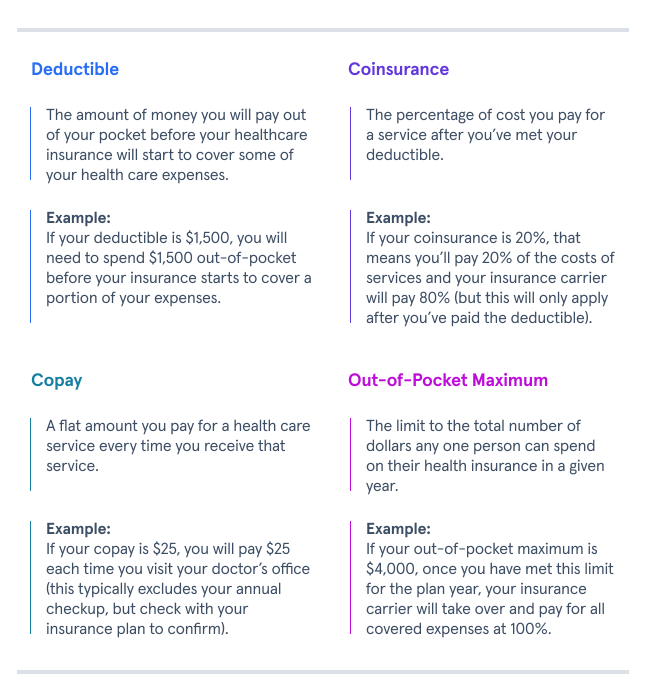
When you enroll in a medical plan and receive your medical ID card, you may be stumped by what the different terms and numbers on that card mean. You may have heard words like “deductible” and “coinsurance,” but what exactly do these terms mean for you and your wallet?
Simply put, deductibles, coinsurance, copays, and out-of-pocket maximums are all insurance terms that indicate cost share. We’ll go over the basics of what these terms mean and how to find out how much they will cost you (based on your health insurance plan).
We’ll also provide the key points to know when picking a health plan that best suits your individual needs.
Key Takeaways
A copay is a flat amount that you pay when you go to a specific facility--say, a $20 copay for a visit to your primary care physician.
A deductible is an amount you pay before the insurance carrier begins to pay a portion of your claims.
Once you exceed your deductible, you will pay a portion of any further claims incurred while the insurance carrier pays the remainder. This is referred to as “coinsurance.”
Lastly, the out-of-pocket maximum is the absolute maximum amount of money that any individual will be liable for paying in a given plan year.
Deductible vs. Coinsurance vs. Copay
If you’ve ever had to choose a health care plan for you or your family, you know how difficult it could be to understand. Insurance terms such as “deductible,” “coinsurance,” and “copay” may be things you have heard before, but it can be challenging to understand how they all function in practice.
To help you make the best decision for your health insurance, let's first dive into what these terms mean.
What is a Deductible?
A deductible is the amount of money you will pay out of your pocket before your healthcare insurance will start to cover some of your health care expenses. In a given year, you are expected to pay this amount before your healthcare insurance kicks in. Your deductible resets yearly.
For example, if the deductible associated with your health plan is $1,500, this is the amount that you will need to pay out of pocket before your insurance carrier begins to pay for a portion of your claims. Once you have hit your deductible amount of $1,500, your health insurance carrier will begin to cover a majority of the costs you incur for the remainder of the year.
Another feature of deductibles is that they are often the biggest determinant of your monthly healthcare premiums. Therefore, if health care premiums are a big concern of yours, it is worth looking at the deductible of each plan available to best estimate how costly it will be to enroll in that plan.
Enrolling in a plan with a higher deductible (commonly referred to as a high deductible health plan or HDHP) may be in your best interest, as these tend to be the most cost-effective plans. However, if you expect to have many health care costs, a plan with a lower deductible would be more cost-effective. A lower deductible means there will be a smaller amount that you will need to pay before the insurance carrier begins to pay its share of your claims: the coinsurance.
What is Coinsurance?
Coinsurance is the percentage of cost you pay for a service after you’ve met your deductible. Your health insurance provider will cover the remaining percentage of the cost.
Following the previous example, if your deductible amount is $1,500, then the amount of health care costs that exceed that will be shared between you and the insurance carrier.
For instance, if your coinsurance is 20% for a medical service, you will be expected to pay 20% of the cost of that service. Your insurance provider will cover the remaining 80% of the cost.
In some instances, you may have the ability to enroll in a plan that has 100% coinsurance for in-network services. This means that once you meet your deductible, the insurance carrier will cover 100% of the costs you incur for the remainder of the year, as long as you are visiting in-network facilities and regardless of what your out-of-pocket maximum is.
What is a Copay?
A copay is a flat amount you pay for a health care service every time you receive that service. You will pay this amount at the time you receive the service. Not all plans will have copays, and not all services will have copays. Moreover, copays typically only apply to in-network facilities.
Often, you can see plans that will use a combination of copays, coinsurance, and deductibles. Depending on your plan, your copay may contribute towards your annual deductible.
An example of when you might have a copay is when you visit your primary care doctor. If your copay is $30, this means that every time you visit your doctor's office, you will pay $30 out-of-pocket. Another typical instance in which you may have a copay is for emergency room visits. If your emergency room copay is $100, you will pay $100 out-of-pocket every time you visit the emergency room.
This combination of deductibles, coinsurance, and copays will be the primary way in which your benefits pay out until you meet your designated out-of-pocket maximum for the year.
What is an Out-of-Pocket Maximum?
By now, you may be familiar with insurance terms such as “deductibles” and “coinsurance,” but what exactly is an out-of-pocket maximum?
The out-of-pocket maximum is the limit to the total number of dollars any one person can spend on their health insurance in a given year, and its purpose is precisely that--to make sure that an individual isn’t liable for exorbitant amounts of money to pay for their medical expenses.
What Does “Out-of-Pocket Maximum” Mean?
The out-of-pocket maximum comes into play once you have already met your deductible and you are sharing health care costs with the insurance carrier through coinsurance.
Once your health care costs exceed your deductible value, you will split the costs with the insurance carrier--at a predetermined coinsurance value--until your expenses have met the out-of-pocket maximum for that year.
So if your out-of-pocket maximum is $4,000, once you have met this limit, the insurance carrier will take over and pay for all covered expenses at 100%.
To further ensure that the out-of-pocket maximums that insurance carriers are issuing to their customers aren’t too high, the federal government sets certain limits each year. This number does change annually, but it is put in place through the Affordable Care Act so that the US government can make sure that no single insurance carrier--through ACA-compliant health plans--is issuing an out-of-pocket maximum that is considered to be “too high”.
For example, the 2021 limit on out-of-pocket maximums is $8,550 for an individual and $17,100 for a family. For 2022, the individual maximum will be $8,700, and the family maximum will be $17,400.
This means that the out-of-pocket maximum associated with your health plan for the year could be set at a value lower than $8,550 for an individual, but it cannot exceed this amount for 2021 plan years.
Out of Pocket Maximums: Individual vs. Family
As mentioned above, there are separate out-of-pocket maximums allocated to individuals and families. But, how is this distinction made, and what does that mean? To start simply, if you enroll in health insurance as an individual with no dependents, the only maximum you will need to worry about is the individual out-of-pocket maximum.
To recap, here are a few main takeaways to explain what an out-of-pocket maximum is and how it impacts you:
An out-of-pocket maximum limits the amount of money any person will need to pay on their health care in a given year.
Once you meet your out-of-pocket maximum for a given plan year, the insurance company will cover the remainder of the costs for the plan year.
The maximum associated with your health plan can vary, but it cannot exceed the government-mandated limits for your plan year.
The limits on out-of-pocket maximums for 2021 plan years are $8,550 for individuals and $17,100 for families.

How to Find the Right Plan for Your Needs
Now that you have a better understanding of deductibles, copays, coinsurance, and out-of-pocket maximums--as well as how they integrate--you can now make a better decision when it comes to finding a suitable plan for your needs.
Whether you want to prioritize affordability, value, or finding a middle ground between the best benefits and a reasonable price, the combination of deductibles, copays, coinsurance, and out-of-pocket maximums will be the most significant determinant of whether or not that plan is right for your needs.
When selecting your next medical plan, try to keep a few things in mind:
Do you have any chronic conditions that may require you to visit outpatient facilities or inpatient facilities regularly?
Are you expecting to get pregnant this year?
If you incur a large medical cost in the year, what is the maximum that you could afford to pay out of pocket?
Do you have many dependents that may require more than just routine care in the year?
If you are hoping to keep your medical premiums low, a plan with a higher deductible and out-of-pocket maximum would likely fit your needs. If you are entering a year where you are expecting some higher-cost medical procedures, it may be in your best interest to select a plan with higher premiums but a lower deductible.
Selecting a medical plan always takes some consideration--the circumstances of every individual can vary a great deal in any given year. That is why it is important to understand exactly what your benefits mean and choose the right plan for your situation.







